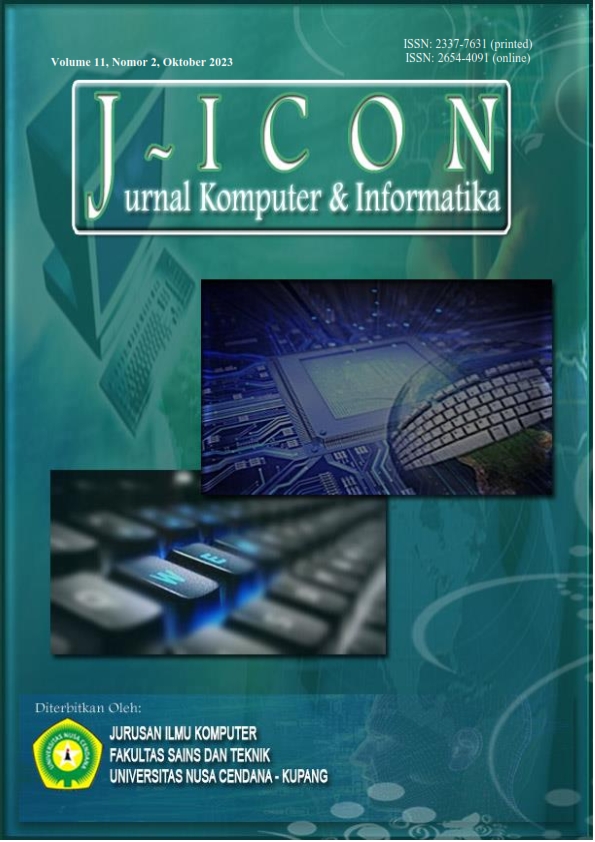ANALYSIS OF UI/UX APPROACHES TO ANDROID APPLICATION DESIGN AT THE JHON STORE
Abstract
Jhon's Shop is a shop that sells various kinds of necessities for other smaller shops. Along with its development, Toko Jhon wants to add digital marketing methods to its products. The aim of this research is to design a user interface and user experience (UI/UX) for the Toko Jhon mobile application by applying the user-centered design method with four stages namely, specifying the context of use, specifying user requirements, designing solutions, and evaluating against requirements with heuristic evaluations to carry out the evaluation. User interface and user experience are important factors to ensure that users are comfortable when using the application. In the Design Solutions Stage, the author carries out low-fidelity and high-fidelity designs with the help of the Figma application. After the design is formed, an evaluation is carried out using heuristics, assisted by an evaluator. The results of calculations using the heuristic evaluation method showed that 18 statements were included in the Good and Very Good qualifications, and there were 2 statements included in the Fairly Good and Not Good qualifications, which were found in the Heuristics Help and Documentation aspect with recommendations for improvement namely, adding a help button and a contact admin feature. After improvements have been made, the UI/UX design is ready to be implemented in the application prototype.
Downloads
References
S. Mulyani, Metode Analisis dan perancangan sistem. Bandung: Abdi Sistematika, 2017.
M. Y. Simargolang and N. Nasution, “Aplikasi Pelayanan Jasa Laundry Berbasis WEB,” J. Teknol. Inf., vol. 2, no. 1, pp. 6, 2018. doi: https://doi.org/10.36294/jurti.v2i1.402.
R. Darmawan, “Pengalaman, Usability, dan Antarmuka Grafis: Sebuah Penelusuran Teoritis,” ITB J. Vis. Art Des., vol. 4, no. 2, pp. 95–102, 2013, doi: https://doi.org/10.5614/itbj.vad.2013.4.2.1.
M. B. Wiryawan, “User Experience (Ux) sebagai Bagian dari Pemikiran Desain dalam Pendidikan Tinggi Desain Komunikasi Visual,” Humaniora, vol. 2, no. 2, pp. 1158-1166, 2011, doi: https://doi.org/10.21512/humaniora.v2i2.3166.
P. Krisnayani, K. Resika Arthana, and G. Mahendra Darmawangsa, “Analisa Usability Testing Pada website Undiksha Menggunakan Metode Heuristic Evaluation,” Kumpul. Artik. Mhs. Pendidik. Tek. Inform., vol. 5, no. 2, pp. 98, 2016. doi: https://doi.org/10.23887/karmapati.v5i2.8306.
I. S. Y. Saputri, M. Fadli, and I. Surya, “Implementasi E-Commerce Menggunakan Metode UCD (User Centered Design) Berbasis Web,” J. Aksara Komput. Terap., vol. 6, no. 2, pp. 269–278, 2017. [Online]. Available: http://orcid.org/0000-0002-4172-4086. [Accessed 31 October 2023].
M. A. Kusumadya, R. Rasmila, F. Hidayat, and D. Chandra, “Analisis Website Petani Kode Menggunakan SUS (System Usabilty Scale),” J. Inform. Polinema, vol. 8, no. 4, pp. 41–46, 2022, doi: https://doi.org/10.33795/jip.v8i4.908.
B. E. Sumbono, D. Erlansyah, and R. Rasmila, “Aplikasi E-Commerce Sebagai Media Penjualan Berbasis Web Pada Toko Mau Pempek,” J. Nas. Ilmu Komput., vol. 1, no. 4, pp. 183–194, 2020, doi: https://doi.org/10.47747/jurnalnik.v1i4.165.
R. Rasmila, D. Darwin, M. D. Permana, and Y. D. Pebriani, “The Plant Marketplace Indonesia in Android on Pagar Alam Nursery,” CESS (Journal Comput. Eng. Syst. Sci., vol. 7, no. 1, pp. 225, 2022, doi: https://doi.org/10.24114/cess.v7i1.29792.
Galih Reksa Lingga Respati and Dana Indra Sensuse, “Evaluasi Antarmuka Prototype Aplikasi Beranda Layanan Dengan Metode Heuristic Evaluation,” J. RESTIKOM Ris. Tek. Inform. dan Komput., vol. 3, no. 3, pp. 130–139, 2022, doi: https://doi.org/10.52005/restikom.v3i3.90.
Copyright (c) 2023 Rasmila Rasmila, Yogi Mardiyansya, Devi Udariyansyah, Siti Sauda

This work is licensed under a Creative Commons Attribution 4.0 International License.
The author submitting the manuscript must understand and agree that if accepted for publication, authors retain copyright and grant the journal right of first publication with the work simultaneously licensed under a Creative Commons Attribution (CC-BY) 4.0 License that allows others to share the work with an acknowledgment of the work’s authorship and initial publication in this journal.
 Rasmila Rasmila(1)
Rasmila Rasmila(1)




